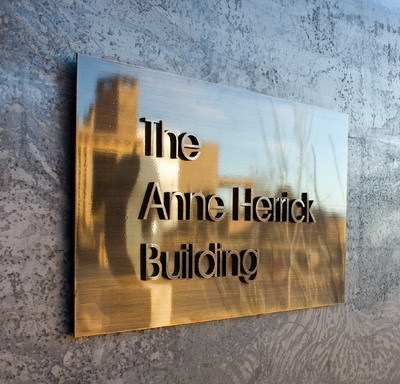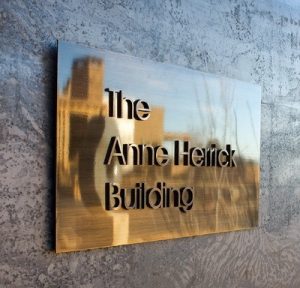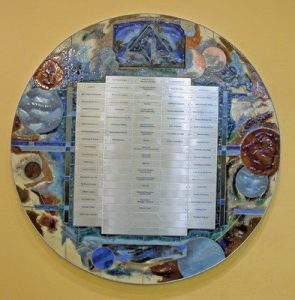News
Banking on Success
A financial-services expatriate creates a new niche in the sign industry.
Published
15 years agoon

When people ask me what I do for a living, I proudly tell them I write about the sign industry. They often respond, “What do you mean…signs?” I remind them of the signage and wayfinding that identified and helped guide them to the stadia, shops or restaurants they frequently visit. Each time, I win another convert to the importance of signage.
Similarly, Roxanna Meyers, president of Century Sign Builders (Albuquerque, NM), didn’t initially envision owning a signshop as her next career as she planned her exodus from the financial-services industry to begin an entrepreneurial venture. But, after carefully vetting the sign industry’s opportunities, she liked the opportunities the right signshop could provide. Twelve years later, she’s transformed her shop into one of the leading architectural-sign providers throughout the Land of Enchantment and beyond, and plans to expand her work towards the West Coast. For all the differences between the banking and signmaking industries, Meyers understood the value of building and maintaining relationships would transfer from one occupation to the other.
Creating a new path
After having graduated with a marketing degree from the University of Arizona’s business school, Meyers went to work for a small bank in Albuquerque. She soon realized her “balance of left- and right-brain abilities” would provide both the financial and people skills required for success in the commercial-lending field.
“I enjoyed the opportunity to meet business owners, listening to their situations and opportunities, and finding solutions for their issues,” she said.
Her excellent work earned her swift promotion, and she ultimately became president of Wells Fargo’s Alququerque Community Banking. However, for all of her success, she still craved the autonomy and challenge of entrepreneurship.
Advertisement“In my early 30s, I decided that I wanted to own my own business by the time I was 40,” Meyers said. “I was willing to consider any opportunity, provided it offered a good profit margin, broad opportunity and a necessary product or service.”
From her sister, Monica, she learned of the opportunity to purchase Century Sign Builders. Befitting a banker’s methodical nature, Meyers spent eight months vetting the company’s workflow and historical financial data, as well as researching how general contractors purchase signage, before making her decision to buy the company in 1997 (she assumed the reins one year later). After having reviewed many of the larger architectural-sign companies, she determined that most of them didn’t handle complete design, fabrication and installation.
“I don’t know that any business can be termed recession-proof, but, as long as architects need visual communications for their buildings, there will always be a need for our products and services,” Meyers said. “I already enjoyed longstanding reIationships with many area architects and commercial builders, which provided strong opportunities to market a full-service, architectural signshop. So, I decided this was the right opportunity, sold my Wells Fargo stock and took out a loan to start my business.”
Making her mark
AdvertisementMeyers promptly instituted several changes. The shop, which then measured 6,000 sq. ft. and employed 10 workers, only operated two PCs – one ran the engraver and the other served the accounting department. She said, “We literally made one sign at a time.”
Meyers remedied this by outfitting every employee with a PC and up-to-date software. And, she hired the first in-house designer to the staff, and later created three design and project-management teams and increased pre-production staff. Despite the initial cash outlays, Meyers streamlined the shop’s cashflow to save enough money to allocate at least $50,000 per year to invest in capital-equipment and software upgrades.
To find equipment to meet Century’s growing production needs, she attended her first ISA show in 1999. She commented, “Being new to the industry, it amazed how many people were involved with signage. I found them to be very passionate about their craft. It was a revelation to find a resource like [ISA].”
She now owns three Vision Engraving Systems engravers to fabricate Century’s ADA signage, a Graphtec America Inc. plotter, a dye-sublimation press, a large-format Encad printer and a recently purchased Roland DGA Corporation VP-540 eco-solvent printer. Meyers has considered purchasing a flatbed printer, but hasn’t yet decided that it meets her market’s needs.
In March 2006, Meyers moved the company into a newly renovated, 12,000-sq.-ft. facility that provides significant showroom space to highlight the company’s design, fabrication and installation capabilities.
AdvertisementShe said her work divides relatively evenly between corporate environments, healthcare facilities and educational institutions. The company maintains several national accounts, such as DeVry Technical Institute. They also created environmental-graphics package for the Santa Fe Civic Center. With a few exceptions, Meyers avoids retail clients because of that market’s provider saturation and often frantic turnaround times.
To grow the company, she realized it would need to evolve from a job shop to stocking its own product line. Through Century’s website, www.csbsigns.com, the company offers a standard repertoire of ADA, directory and architectural signage. Meyers said, “We’ll always offer custom solutions, but standard, in-stock materials and specs suit most of our customers’ needs.”
The company derives approximately 15% of its work from architectural signage that it wholesales to others. The company typically purchases architectural letters from Gemini or US Sign and purchases post-and-panel signs from Charleston Industries or Jackson Brooks. Meyers estimates the company produces 60% of its signage inhouse. She said, “Because we offer a broad line of products and services, it sometimes makes more sense for us to handle design and project management and subcontract fabrication. We sub out electrical-sign fabrication, waterjet-cut applications and small orders that wouldn’t efficiently use our capacity.”
Goals and objectives
Century Sign Builders’ ongoing success affirms Meyers’ plan. The company, which has grown to 24 employees, has opened a second location in Phoenix. She continually seeks to enhance processes and product lines by encouraging her entire staff to submit ideas through the company’s Bright Ideas program. The winner receives two free airline tickets and two extra vacation days. Meyers said, “Ideas that come from those doing the work are the best; they know what needs to be done.” Roxanna also endorses bottom-up relationship management.
“It’s the business owner’s job to serve as a rainmaker, and make strategic decisions and directional changes, but I encourage my entire team to build relationships as well,” Meyers said. “I may know the owner of an architectural or contracting firm, but if we’re not on good terms with a project manager or estimator, the project is less likely to succeed.”
Inspired by Jack Stack’s book, The Great Game of Business, she instituted an open-book management philosophy and provides detailed financial statements to all employees. She acknowledged it took time to train her staff to translate financial statements, but their deeper understanding of the company’s direction and internalization of their roles in the company’s success have reaped benefits.
The company currently serves a global market. The company has shipped its wholesale fabrication projects to 47 states. Century recently received a request to quote a project for Education City in Doha, Qatar. Meyers said, “In today’s business climate, you have to think globally to be successful. As always, success is built on finding and maintaining productive relationships.
Even amidst economic turbulence, she remains optimistic: “Many of the Western states have been hit pretty hard during the economic recession. But, New Mexico didn’t experience the boom of other places, so it’s remained relatively stable; sales are only off 4% versus last year. It’s been our goal to maintain and cultivate our niche. In spite of Arizona’s struggling economy, Phoenix is a five times larger market than Albuquerque, which will still provide ample opportunity.”
Meyers aspires to build a brand as well. She said, “It’s important to do good work, but it’s also vital to make your presence known. We call or e-mail past clients several times a year to find out if they have any additional needs. And, in addition to benefitting your community, philanthropy is important because it gives you positive recognition. With all of the technology and resources available, it’s a great time to own a signshop.”

SPONSORED VIDEO
Introducing the Sign Industry Podcast
The Sign Industry Podcast is a platform for every sign person out there — from the old-timers who bent neon and hand-lettered boats to those venturing into new technologies — we want to get their stories out for everyone to hear. Come join us and listen to stories, learn tricks or techniques, and get insights of what’s to come. We are the world’s second oldest profession. The folks who started the world’s oldest profession needed a sign.
You may like

5 Reasons to Sell a Sign Company Plus 6 Options

Sign Products Wrap-Up for April

2024 Women in Signs: Alicia Brothers
Subscribe

Bulletins
Get the most important news and business ideas from Signs of the Times magazine's news bulletin.
Most Popular
-

 Tip Sheet1 week ago
Tip Sheet1 week agoAlways Brand Yourself and Wear Fewer Hats — Two of April’s Sign Tips
-

 Ask Signs of the Times2 days ago
Ask Signs of the Times2 days agoWhy Are Signs from Canva so Overloaded and Similar?
-

 Real Deal1 week ago
Real Deal1 week agoA Woman Sign Company Owner Confronts a Sexist Wholesaler
-

 Benchmarks4 days ago
Benchmarks4 days ago6 Sports Venue Signs Deserving a Standing Ovation
-

 Editor's Note2 weeks ago
Editor's Note2 weeks agoWhy We Still Need the Women in Signs Award
-

 Women in Signs1 week ago
Women in Signs1 week ago2024 Women in Signs: Megan Bradley
-

 Photo Gallery6 days ago
Photo Gallery6 days ago21 Larry Albright Plasma Globes, Crackle Tubes and More
-

 Product Buying + Technology2 weeks ago
Product Buying + Technology2 weeks agoADA Signs and More Uses for Engraving Machines















